Video
Clinical Significance of MRD Testing in MM
Keith Stewart, MB, ChB: If we’re using all these drugs together, it’s getting superexpensive for patients—you know lenalidomide, carfilzomib, daratumumab are all very expensive drugs. Do you see a day in sight, Rafael, where we might consider stopping therapy and not continuing it forever?
Rafael Fonseca, MD: Of course. I think that’s the point that Andrzej made before. It’s incredibly important. I do see a future where we’re going to have a fixed duration of treatment that will result in MRD [minimal residual disease]—negative in a substantial fraction of patients. That would allow the treatment to be shorter, and ultimately to be cheaper. And then once the drugs become generic in the future, it will be incredibly cheap. Think about the 2000s, when the first wave of long-term sustained remissions in myeloma came to be.
Andrzej Jakubowiak, MD, PhD: We already have evidence this is actually happening. Because to some extent, the IFM/DFCI2009 study had provided a lot of data. Transplant is still needed in the novel era, which I completely value as the most important outcome of this study, and we mentioned it briefly. In the patients who have been treated with or without transplant but achieve MRD-negative status and CR [complete response], when they looked at their survival curves, they were very comparable, not statistically different. That guides us now that we’re achieving this level of response. No matter what you do, getting there eventually gives you that chance. And the probability of relapse for this patient was relatively low, and I think we can narrow that gap completely to 10%.
Keith Stewart, MB, ChB: Mary, do patients understand minimal residual disease and what its implications are, or is that just a bridge too far for them?
Mary E. DeRome: No, they’re beginning to, and we certainly are concentrating on educating patients in that area, because we really feel it’s a necessary development in the field to be able to use MRD as a surrogate end point in clinical trials and to help guide treatment decisions. We’re trying to prepare them as best we can to understand what those results mean.
Keith Stewart, MB, ChB: Are you doing much MRD testing, Rafael?
Rafael Fonseca, MD: Yes, I am. There are 2 scenarios in which I do it: prognostic at day 100 post stem cell, and I do it in patients who have long-term sustained CRs, on therapy, to have the conversation about discontinuation of therapy.
Keith Stewart, MB, ChB: And, you, Andrzej?
Andrzej Jakubowiak, MD, PhD: We have, as a standard of care, our own...base MRD, which is aspiring to be EuroFlow flow level, 10-5. We are tuning it up. But for the most part, because we run all these patients who are on trials also single...
Keith Stewart, MB, ChB: You’re not using moleculars that much?
Andrzej Jakubowiak, MD, PhD: We are. Most of our patients are on clinical trials. I actually have for most of our patients 2 results. Both flow and next-generation sequencing. There is about a 10% to 15% difference that we will have a patient who is MRD-negative by flow, would be still positive by next-generation sequencing. We are about to launch commercial use of that test, which is now FDA approved. We will be using it fairly regularly. Because so many patients in our treatment achieve complete response, they are on long-term maintenance. We believe that at some point we will learn that a patient who has sustained MRD-negativity for a year or 2, or more, will be able to be approaching this question, “Can we stop or not?” In a way we are trying to predict that moment by collecting the data already. I yearly check patients and complete response, and we have this information.
Rafael Fonseca, MD: If I could just expand on that and walk through a logic. If a patient is going to get maintenance, myeloma experts will disagree whether they can get 1, 2 years, or indefinitely. And all those answers are correct by current standards. I think it’s perfectly fine to discontinue therapy in someone who has had a sustained CR with MRD-negativity at 2 or 3 years. The person could have stopped therapy even without doing the testing, but it just adds information.
If someone is struggling with a little bit of toxicity, and they’re wondering whether they should continue or not, and they’re MRD-positive, maybe they’ll want to try for a little bit longer of therapy. On the other hand, if someone has a CR but they’re unsure about stopping therapy, and they get an MRD-negative result at 3 years, I think maybe the person is going to be a little bit more confident. There’s just 1 more bit of information that comes into the bedside to make decisions.
Keith Stewart, MB, ChB: To be the devil’s advocate here, there’s really no plateau in the curve even if you’re MRD-negative. People are still relapsing. So why are you so confident they can use that?
Rafael Fonseca, MD: Because the argument again goes to how long is a standard duration of maintenance therapy? And if there was no plateau then, you would say no one should only get 1 or 2 years, right?
I would counter that the Spanish group, even before we had maintenance or MRD, does show that CR patients can go into that plateau. Their subsequent publication doesn’t show that plateau. But I think that study that was published in Blood in 2011 does show, as the studies have shown from the University of Arkansas, as we see anecdotally in our clinic, there’s a small cell set of patients, hopefully growing, that will have sustained CRs and never again require intensive therapy for myeloma.
Keith Stewart, MB, ChB: Mary, when I was at the hematology meeting last December, somebody coined the phrase, “MRD Anxiety,” which we do know is MRD testing.
Mary E. DeRome: I’ve seen that in patients.
Keith Stewart, MB, ChB: I was going to ask you: Are you seeing that in patients?
Mary E. DeRome: I have seen patients who have called and said, “Oh no, I’m MRD-positive,” and they’re handed a number, and they would have no understanding of what that means.
Keith Stewart, MB, ChB: And then they try to overtime it.
Mary E. DeRome: Yes, yes.
Keith Stewart, MB, ChB: I’ve noticed the same thing. In fact, it makes me anxious as a physician because it’s almost a curse, because it used to be, “Well, you’re doing really great. Your bone marrow is normal, your blood is normal.” Now you’re like, “Oh, sorry, you’ve got MRD-positive disease.”
Mary E. DeRome: But I wanted to ask a question too. As we’re talking about what’s happening in your centers, which wouldn’t necessarily be considered community care centers, what is happening in the community as far as MRD?
Keith Stewart, MB, ChB: What I’ve heard the committee doctors saying is that they’re not performing MRD. They understand it, and they understand the value, but I think there’s not enough evidence for them to start adopting it at this point. In fact, even some of our academic colleagues I think feel it’s being oversold and is not to be used for decision making. And what I had Dr Bart Barlogie tell me that 1 day, for example.
Andrzej Jakubowiak, MD, PhD: And probably rightly so because I don’t think we have data at the moment, and your comment about no development of the tail of that curve is a good argument that we haven’t gotten there. But we haven’t really addressed 1 important issue. MRD is a big basket, which we are sometimes forgetting to maybe define a little better. And there is a different layer of MRD. Any MRD prediction is able to help us with what the outcome will be. You achieve MRD-negativity, and the probability of staying longer in remission is essentially indicated.
But if you have MRD-negativity—say, 10-4, 10-5, it doesn’t mean exactly the same as 10-6. And probably we need to go even deeper, in my personal opinion, 10-7 and achievable. So that eventually…
Keith Stewart, MB, ChB: When you look at mass spectrometry, it’s still positive, so it’s kind of depressing.




